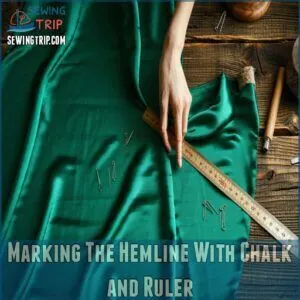This site is supported by our readers. We may earn a commission, at no cost to you, if you purchase through links.

Cut any extra fabric carefully with sharp scissors.
Fold the raw edge up by 1/2 inch, then another inch, pressing each fold with an iron for a crisp finish. Pin the fold every 4 inches to keep it secure.
Sew the hem using matching thread, either by hand with a blind stitch or with a sewing machine. For no-sew options, consider fusible hem tape. Different fabrics may need special adjustments.
Table Of Contents
Key Takeaways
- Mark your hemline with chalk while wearing your shoes to ensure even length and alignment.
- Fold the raw edge twice, press it with an iron, and secure it with pins for a polished finish.
- Use a sewing machine or hand-sew evenly with matching thread to achieve neat, professional results.
- Try fusible hem tape for a quick, no-sew option, especially for emergencies or temporary fixes.
Hemming a Dress Made Easy
Hemming a dress doesn’t have to be complicated if you follow simple steps. Start by gathering your tools, measuring accurately, and preparing the fabric properly for clean results.
Preparing for The Hemming Process
Careful preparation is key to a smooth hemming process. Start by gathering a measuring tape and taking precise dress measurements. It’s like drawing a map before a big journey—accuracy matters! Pre-wash and iron your fabric to prevent shrinking later.
For more advanced techniques, explore these quick dress hemming techniques. Use fitting techniques by trying the dress with shoes to check the desired length. Remember, a consistent seam allowance, about 1-2 inches, guarantees a polished look.
- Measure and mark the hemline before cutting.
- Align seams and lay the dress flat.
- Iron wrinkles for clear markings.
Hemming starts with preparation.
Essential Tools and Materials Needed
Before you start hemming, gather your measuring tape, fabric scissors, thread, needle, and pins.
Add tailor’s chalk for marking lines and a sewing machine for smooth stitching. Sharp scissors cut clean edges, and pins hold folds steady.
Matching thread blends into your fabric. You can find a variety of dress hemming tools online.
These tools transform a basic hem into a polished edge, ready for every occasion, with smooth stitching.
Tips for a Professional Finish
Professional hemming requires precision and patience. For hem accuracy, measure carefully and mark precise lines.
Choose fabric wisely, as this affects folding and stitch quality. Use fold techniques like double-fold hems to hide edges and create a flawless hemline.
Maintain a consistent seam allowance, about 1 inch, for a polished look. Space stitches evenly, whether hand-sewing or using a machine.
Press each fold flat to smooth wrinkles. These hemming techniques guarantee a professional finish that looks clean and lasts.
How to Hem a Dress Professionally
You can hem a dress professionally with careful measuring and precise cutting. Use tools like chalk, pins, and sharp scissors to make sure clean edges.
Measuring and Marking The Hemline
Let’s get your hemline just right.
Wear the dress with your favorite shoes and stand on a flat surface.
Follow these steps:
- Use a measuring tape to mark your desired hemline evenly.
- Add a seam allowance of 1-2 inches.
- Check hem alignment using chalk or pins.
- Ask a friend to verify fabric marking stays level all around.
Cutting The Excess Fabric Accurately
Use sharp fabric scissors and follow your marked hemline carefully. Cut slowly along the hemline, keeping your hand steady.
Stay true to your hem measurement for clean, accurate trimming. Check the fabric grain to prevent uneven cuts.
Leave a seam allowance of 1-2 inches for sewing. Remove excess fabric with care to avoid mistakes during this important fabric-cutting step.
Preparing and Marking The Hemline
Put on the shoes you’ll wear with the dress and stand straight. Use chalk and a ruler to mark the hemline all around, keeping measurements consistent.
Determining The Desired Hem Length
Measuring a dress hem starts with picking your ideal hem style. Think about body proportion and where the dress hemline should land—mini, midi, or maxi.
For accurate marking, consider using essential hem marking tools.
Measure from your waist or shoulder down for the exact length reduction. Remember, fabric choice can affect the hem length and drape, so account for changes before marking your hem.
Using Footwear as a Reference
When hemming a dress, always wear the shoes you’ll pair with it.
Heel height affects how your dress falls, so slipping into your footwear makes sure the hemline matches your ideal length.
Check your hem length on flat, even flooring for precision.
Proper footwear fit also prevents surprises, keeping your dress elevation balanced and your hem looking flawless.
Your dress will have a balanced look when the heel height is considered, thus ensuring a perfect fit.
Marking The Hemline With Chalk and Ruler
For precise hemline measurement, start by aligning a ruler along the dress’s bottom edge.
Use chalk marking every few inches for clarity, and choose fabric-friendly chalk for smooth application.
Maintain ruler alignment to guarantee hemline accuracy, and double-check markings are even.
Gently crease the fabric while marking to avoid distortions, and use a reliable measuring tape to complement the process.
A professional, polished hem is achieved by following these steps, helping to ensure a high-quality finish.
Folding and Securing The Hem
Fold the raw edge of the fabric twice to hide it and create a clean finish. Use pins placed every 4 inches to secure the fold evenly before sewing.
Folding The Raw Edge of The Fabric
Mastering hem folding starts with precise folding to create even folds.
Follow this simple process:
- Fold the raw edge inward by 1/2 inch, aligning the fabric’s natural grain.
- Press with an iron for fabric creasing and uniform length.
- Fold again by 1 inch for edge finishing, ensuring consistent folding and seam allowance.
This process is crucial for achieving professional-looking hems, and by following these steps, you can ensure a uniform length and a neat finish.
Using Pins to Secure The Fold
Pin placement is key for hem security and fold accuracy when hemming a dress.
Insert sewing pins vertically every 4 inches, keeping them evenly spaced to hold the fold steady. Push pins through the fabric layers at a slight angle for extra grip.
This prevents shifting while sewing and guarantees a clean, professional finish. Use straight pins with rounded tips for delicate fabrics and avoid stretching the fabric as you pin.
Well-placed pins maintain seam allowance and fabric tension, making sewing smooth and the hemline flawless. It’s a simple step for reliable results.
Fusible Hem as a No-Sew Option
Fusible hem tape is the ultimate no-sew option for hemming a dress quickly.
You can purchase fusible hem tape online.
Here’s how to use it with fabric adhesive and iron methods:
- Pre-wash and iron the fabric.
- Cut fusible web or hem tape to hem circumference.
- Fold the fabric and place the tape inside.
- Press with a hot iron.
- Let cool before wearing, ensuring a secure and quick hem.
Sewing The Hem With Precision
Use a matching thread and maintain consistent stitches to achieve a clean finish. Whether you’re hand-sewing or using a machine, keep the seam straight and even.
Hand-Sewing With a Blind Stitch
When hemming a dress, learning the art of the blind stitch is essential. This hand-sewing technique creates nearly invisible stitches, perfect for a polished look.
You can find helpful blind stitch hem products online.
Follow these sewing tips for professional results:
- Use a thin needle and choose thread that matches your fabric perfectly.
- Fold the hem twice, securing the fabric folds with pins.
- Catch just a small loop of fabric with each stitch to keep it invisible.
- Space your stitches evenly, about 1/4 inch apart.
- Pull the thread gently to avoid puckering.
Using a Sewing Machine for a Straight Stitch
Using a sewing machine for a straight stitch simplifies hemming techniques and guarantees neat results.
For a truly professional finish, learn more about straight stitch techniques.
First, select the right thread and needle to match your fabric. Adjust fabric tension and set the stitch length to 2.5-3mm for precision. Keep the fabric straight and guide it steadily.
| Sewing Machine Tips | Key Steps | Pro Tips |
|---|---|---|
| Thread Selection | Match thread to fabric | Use quality thread |
| Fabric Tension | Adjust for smooth stitches | Test on scrap fabric |
| Hem Speed | Go steady, not too fast | Practice for control |
By understanding these basics, you’ll master how to hem a dress smoothly, and achieve a professional finish with smooth stitches.
Working With Different Fabrics
You’ll need to adjust your hemming method for each fabric type. Thicker fabrics require wider folds, while delicate ones need gentler handling and smaller stitches.
Hemming Formal Dresses With Caution
When hemming a formal dress, take extra care to preserve its elegance and structure.
These dresses often have intricate details that require a steady hand and focus.
Follow these key steps for precision:
- Inspect bead placement and remove any near the hemline.
- Use sharp scissors for clean cuts on delicate edges.
- Handle fabrics like silk and lace with care to avoid damage.
- Support the fabric’s weight while measuring seams.
- Work slowly to achieve an even finish.
Using a Rolled Hem for Delicate Fabrics
A rolled hem is perfect for a delicate fabric like chiffon or silk.
It creates a narrow, clean edge with two small folds.
This rolled hem technique works well on lightweight knits.
Use these tools and steps:
| Hemming Tools | Rolled Hem Tips |
|---|---|
| Lightweight needle | Practice hemming techniques |
| Fine thread | Adjust stitch length carefully |
| Fabric chalk | Mark fabric edges precisely |
| Sharp scissors | Cut a narrow rolled hem evenly |
Keep stitch tension even for best results.
Considering Fabric Grain and Weight
Fabric grain and weight shape how your hem sits and looks.
Watch the grain direction—it affects fabric stretch and drape. Lightweight fabric types, like chiffon, need gentle hemming techniques, such as hand-stitching.
Thicker fabric types, such as denim, work best with machine stitching. A basic hemming technique involves a double-fold hem.
Consider texture impact and fabric thickness to avoid puckering. Match thread choice to the fabric type for a neat, professional hem that won’t unravel.
Tips for a Perfect Hem Every Time
Pre-wash and iron your dress to prevent shrinkage and make sure the fabric is smooth.
Take your time to measure carefully, and always match the original hemline for a polished look.
Allowing Ample Time for The Process
Plan your hemming schedule wisely to avoid rushed results.
Allocate at least two hours for dress hemming, including fabric preparation and sewing techniques. A slower sewing pace guarantees quality.
Unexpected issues can disrupt your alteration timeline, so flexibility matters.
Proper time management turns frustration into success, making every step, from cutting to stitching, part of a smooth dress hemming process.
Maintaining Consistency With The Original Hemline
Ensuring a consistent hemline makes your dress look polished and professional.
Follow these steps:
- Measure carefully: Mark the hemline evenly around the dress for an accurate hemline.
- Check seam matching: Align fabric seams before cutting for an even hem.
- Use precise marking lines: Draw lines every 4 inches to guide cuts.
Consider using quick hemming techniques for efficient results.
Prioritize fold precision: Fold tightly and finish edges cleanly for neat edge finishing.
Pre-Washing and Ironing The Garment
Stop fabric shrinkage with a pre wash—wash your garment first to handle stains and surprises.
To avoid color bleeding, check delicate fabrics carefully.
After prewashing, use steaming techniques or a steam press to iron the dress.
Smooth wrinkles and align seams before hemming.
Press evenly for a polished look and keep the fabric stable for perfect results.
Common Hemming Mistakes to Avoid
When hemming a dress, small mistakes can ruin the final look. Measure accurately, fold evenly, and press properly to avoid common issues.
Incorrect Hem Length Measurement
Getting the hem length right isn’t just about numbers; it’s about precision. Measuring mistakes can ruin the fit.
Skip these common hem errors:
- Ignoring your shoes’ height when marking the hem.
- Forgetting fabric shrinkage after washing.
- Overlooking hem alignment when laying the dress flat.
- Not accounting for body proportions or dress length preferences.
Always take precise measurements, mark an accurate hemline, and measure twice for less chance of length discrepancies to achieve the perfect fit!
Inconsistent Folding and Sewing
Uneven folding and stitching can ruin your hem’s look.
Use proper fold techniques to avoid inconsistent folding. Align pins vertically and keep them snug for solid hem alignment.
Watch fabric tension—it impacts stitch control. Slow down to sew evenly.
Consistent sewing creates an even hem and avoids sewing errors.
Precise folding guarantees clean edges and smooth results. Take your time!
Not Pressing The Hem Properly
An iron smooths hem creases, prevents fabric shrinkage, and guarantees precise folding.
Use pressing techniques to fix inconsistent folding or puckering. Align the hem evenly and press each section flat.
For better hem alignment, steam and check for an even hemline throughout. A good hem technique transforms your work into a polished finish.
Frequently Asked Questions (FAQs)
Can I Hem a Dress Without Sewing It by Hand?
Did you know 54% of people prefer no-sew methods?
Use double-sided fabric tape or iron-on hem tape for simple, quick solutions.
Just measure, fold, and apply, it’s perfect for emergencies or temporary hem fixes.
How Long Does It Take to Hem a Dress by Hand?
Hemming a dress by hand usually takes 1-2 hours, depending on your skill level and dress details.
Plan extra time for pinning, folding, and stitching evenly, especially with thicker fabrics or intricate hemlines.
What Kind of Thread Should I Use to Hem a Dress?
Imagine thread as the glue holding your hem together.
Use polyester thread for stretch and durability or cotton for soft fabrics.
Match thread color to your dress or go slightly darker for a seamless finish.
Can I Hem a Dress That Has a Slit?
Yes, you can hem a dress with a slit.
Just match the slit’s length to your new hemline.
Fold and pin carefully around the slit, ensuring alignment, and sew slowly to maintain the slit’s shape.
How Do I Know if I’ve Hemmed the Dress to the Right Length?
Step onto a level floor and wear your intended shoes.
The hem should skim the ground or match your marked measurement evenly.
Check mirrors for alignment.
Adjust if it looks uneven or too short.
How to hem a dress easily?
Turn the dress inside out, mark your hemline, and cut 2 inches below it.
Fold twice, pin securely, and sew neatly along the edge.
Use a sewing machine or hand-stitch for a professional finish.
How to shorten a dress without sewing?
Cut straight to the chase—use fabric tape or double-sided fashion tape.
Fold the hem, press it flat, and secure it with the tape.
It’s quick, easy, and no needle or thread needed!
Can you hem clothes without a sewing machine?
You can hem clothes by hand using a needle and thread.
Fold the fabric twice, pin it evenly, and sew small, straight stitches along the fold.
Iron the hem afterward for a polished, professional look.
How to hem for beginners?
Hemming’s like outlining a masterpiece—start with a flat dress, measure precisely, mark with chalk, and pin carefully.
Fold edges twice, press with an iron, and hand-sew or machine-stitch evenly for a flawless, custom-made finish.
How to hem a dress with a machine?
Start by marking the hemline with pins, fold it twice, then press it flat.
Use a sewing machine to stitch along the fold, keeping stitches even and matching the thread color to the dress.
Conclusion
Hemming a dress combines planning and precision.
You start by marking an even hemline, then carefully cut extra fabric.
Fold the raw edge twice—1/2 inch first, then 1 inch—ironing each fold for sharp creases.
Secure it with pins or fusible tape for convenience.
Whether you sew by hand or machine, keep stitches straight and neat.
Adjust techniques for different fabrics to avoid mistakes.
By mastering these steps, you’ll know exactly how to hem a dress perfectly every time.

















